Acumatica Cloud ERP is a cloud-based ERP software that offers a consumption-based pricing structure. Financial managers use Acumatica Cloud ERP to manage financial operations, improve productivity, and gain valuable business insights through its comprehensive suite of tools. Compared to its competitors, Acumatica Cloud ERP offers more flexible pricing options that provide good value.
This guide covers everything you need to know about Acumatica Cloud ERP pricing, factors, and costs to make an informed purchase decision with confidence.
How Much Does Acumatica Cloud ERP Cost?
Acumatica Cloud ERP’s pricing model is flexible and based on several factors, including the number of applications implemented, projected resource consumption, and the chosen license type. This model ensures businesses only pay for the functionalities that serve their unique needs and are not charged per user.
Interested parties can schedule a free pricing review with an Acumatica expert to explore their options.
Acumatica Cloud ERP Pricing Factors
Here's an overview of Acumatica Cloud ERP’s pricing factors:
| Plan Type | Price | What's Included? |
| Applications | Pricing upon request | Pricing is based on the number of applications or features needed. |
| Projected Resource Consumption | Pricing upon request | Pricing is based on how much computing power, data storage, and transaction processing the business requires. |
| License | Pricing upon request | Pricing is based on the deployment option selected for the business. Acumatica Cloud ERP offers SaaS Subscription, Private Cloud Subscription (PCS), and Private Cloud Perpetual (PCP) licenses . |
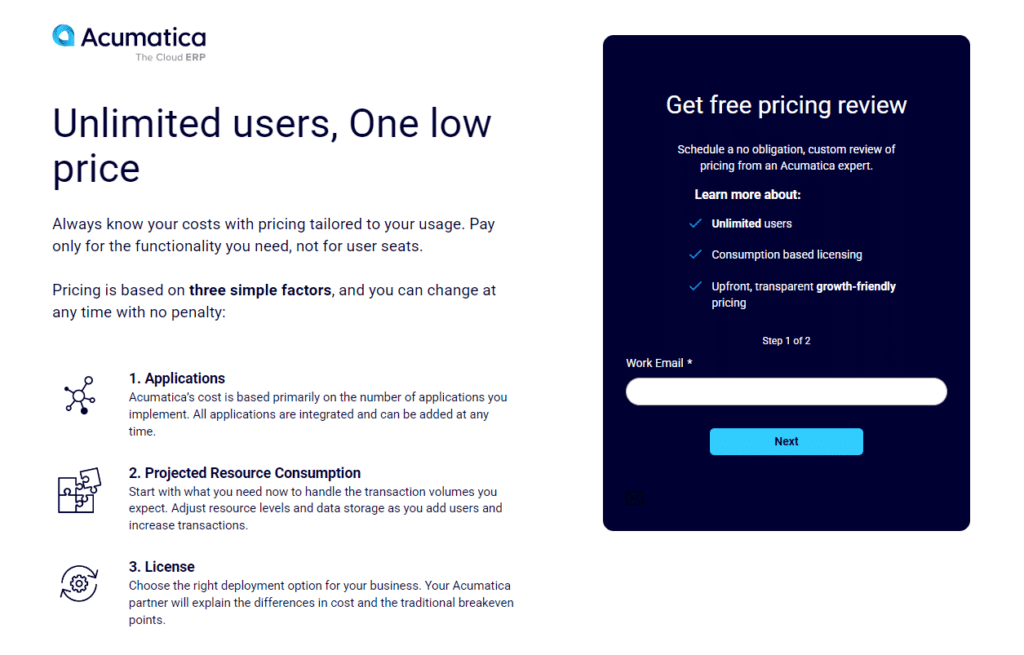
Let’s break down Acumatica Cloud ERP's pricing factors a bit further:
Applications
Acumatica’s Applications pricing factor refers to the software’s various integrated applications that handle different business functions. Examples of applications users can add as their business grows include finance, CRM, project accounting, business intelligence, manufacturing, distribution, and e-commerce.
With Acumatica’s pricing structure, users can add-on new applications as needed, ensuring they only pay for the features they are actively using. They can also add more upgrades at any given time and smoothly integrate it across other applications.
Project Resource Consumption
Acumatica’s Projected Resource Consumption pricing factor refers to the computing resources required for handling transaction volume, including data storage and processing power.
This pricing structure allows businesses to start with minimal data storage and computing power and scale their usage as operations grow, ensuring business owners are charged for the actual use of system resources rather than a per-user cost.
Consequently, Acumatica’s pricing is ideal for companies anticipating growth and needing high resource flexibility.
License
Acumatica Cloud ERP can be deployed through a SaaS Subscription, Private Cloud Subscription (PCS), or Private Cloud Perpetual (PCP) license model.
The software as a service (SAAS) subscription eliminates the need for businesses to invest in and maintain their hosting infrastructure. It offers flexibility, allowing companies to scale their features up or down as their business needs evolve.
The PCS model enables businesses to deploy and manage the software on their servers or have it hosted and managed by a third party.
The perpetual license, or Private Cloud Perpetual (PCP) license, allows businesses to make a one-time upfront payment for the ERP software, granting ownership of the system, with additional annual maintenance fees for ongoing support and updates.
All models allow businesses to add features at any time, but feature removals can only be made during the license renewal period.
Acumatica Cloud ERP Pricing vs. Competitors
Acumatica Cloud ERP offers a flexible pricing model based on applications, resource consumption, and license type, allowing businesses to pay only for the functionalities they need. This approach eliminates the incremental costs associated with per-user licenses, making it ideal for businesses looking to scale. Instead, businesses are charged based on the resources they use, such as transaction volume and data storage, ensuring a tailored cost structure.
Compared to average ERP software costs, which range from $1,000 to $20,000 per month, Acumatica's pricing structure is average, with a focus on providing transparency and accommodating growth without hidden fees. Key features include unlimited users and adjustable resources, which cater well to growing businesses.
Comparison Chart: Acumatica Cloud ERP vs. Alternatives
Wondering how Acumatica Cloud ERP pricing compares to other ERP platforms? Here’s a comparison chart that breaks down the costs of other ERP software side-by-side:
| Tool | Best For | Trial Info | Price | ||
|---|---|---|---|---|---|
| 1 | Best for small manufacturers needing real-time inventory insights | 30-day free trial | From $49/user/month | Website | |
| 2 | Best for AI financial automation | Free demo available | Pricing upon request | Website | |
| 3 | Best for comprehensive ERP with AI-driven insights | Free demo available | From $180/user/month | Website | |
| 4 | Best for small businesses seeking integrated business intelligence | Free demo available | From $56/user/month | Website | |
| 5 | Best for open-source ERP with agile features | 14-day free trial + free demo available | From $50/user/month | Website | |
| 6 | Best for real-time inventory management for manufacturers | Free demo available | From $179/month (billed annually) | Website | |
| 7 | Best for industry-specific ERP solutions | Free demo available | Pricing upon request | Website | |
| 8 | Best for supply chain management and manufacturing | Not available | Pricing upon request | Website | |
| 9 | Best for open-source ERP with extensive app integrations | Free trial available | From $7.25/user/month | Website | |
| 10 | Best for flexible deployment and automating processes | Free demo available | Pricing available upon request | Website |
Alternatives to Acumatica Cloud ERP
Acumatica Cloud ERP is a solid ERP software, but there are plenty of options out there. Depending on your use case, budget, team size, and other factors, you might consider shopping around for a solution that’s better suited to your needs.
If you’re looking for alternative software options to Acumatica Cloud ERP, here are a few other ERP vendors worth checking out:
- Oracle NetSuite: Known for its dynamic and scalable platform, Oracle NetSuite offers advanced automation capabilities across multiple verticals.
- Microsoft Dynamics 365: Microsoft Dynamics 365 provides a user-friendly experience for small to midsize businesses, especially those already using other Microsoft products.
- SAP S/4HANA: SAP S/4HANA is an enterprise-grade solution, ideal for large organizations with broad modules and native integrations.
- Sage Intacct: Popular for its strong financial management capabilities, Sage Intacct offers transparency and ease-of-use.
- Epicor ERP: Tailored for manufacturers and distributors, Epicor ERP provides industry-specific tools and transparent pricing.
- OdooERP: OdooERP is an open-source solution that appeals to small businesses due to its affordability, starting at $20/month.
How to Choose The Right Acumatica Cloud ERP Plan
When deciding which Acumatica Cloud ERP plan to choose, you’ll want to consider each plan’s added value and potential drawbacks. Scrolling through long lists of features can quickly lead to confusion and uncertainty, so here are a few factors to keep in mind as you evaluate and assess your options:
Acumatica Cloud ERP Scalability and Team Size
Evaluating the scalability of Acumatica Cloud ERP is critical for aligning your plan with your team’s size and growth path. Acumatica's pricing is structured based on applications, resource usage, and deployment options, rather than per-user fees, which allows significant flexibility for businesses of all sizes. Small teams can start with fewer applications and lower resource requirements, while medium teams may need more resources as they grow. Large enterprises can adjust data storage and transaction volumes as they grow without incurring additional seat costs. This adaptability ensures that the ERP solution can scale alongside your business, providing a tailored fit for diverse operational needs.
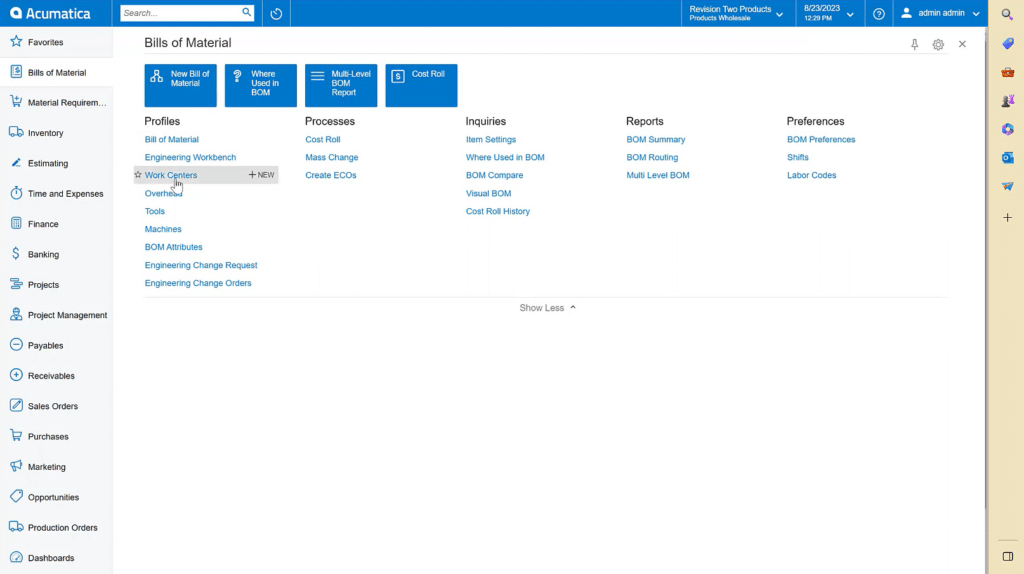
Industry-Specific Acumatica Cloud ERP Features
Evaluating if Acumatica ERP software meets your specific industry needs is crucial for maximizing productivity. Acumatica provides industry-specific features tailored to sectors such as finance, construction, and retail. For example, it offers financial management tools for finance, project management for construction, and inventory management for retail and eCommerce. These specialized features streamline operations and improve efficiency across various industries.
Acumatica’s pricing model is based on the applications you select, your resource consumption, and your method of deployment, allowing for unlimited users without locking features to specific plans. This flexibility ensures that businesses of all sizes can scale efficiently while only paying for the resources they use.
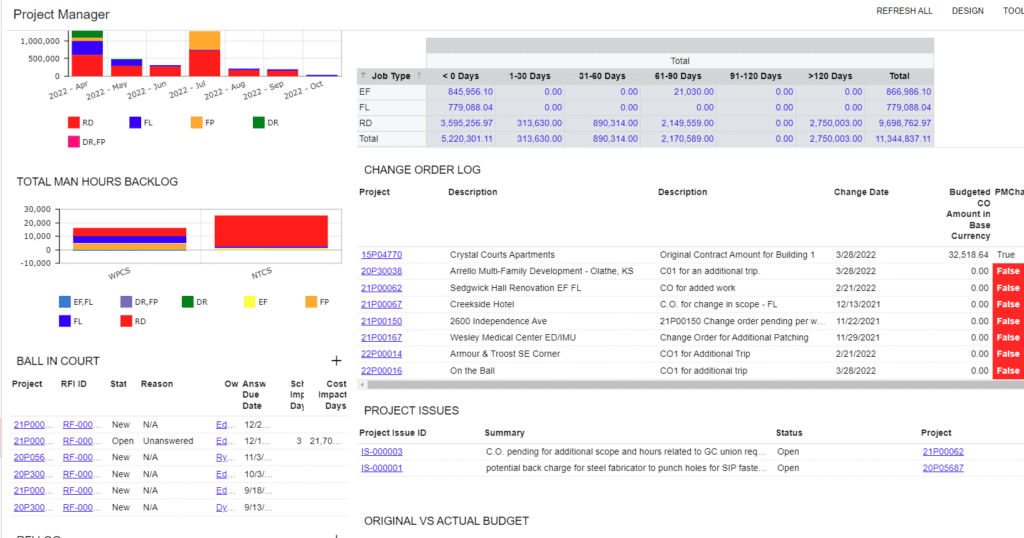
Acumatica Cloud ERP Integration Capabilities
ERP software must connect with your existing tech stack to enhance operational efficiency and data consistency. Acumatica Cloud ERP offers native integrations and connects with several third-party tools, including Shopify, Jira, ADP Workforce Now, CriterionHCM, and DataSelf Analytics. These integrations streamline operations by syncing data across platforms such as financials, payroll, and eCommerce, ensuring that users can manage their workflows seamlessly.
Additionally, Acumatica Cloud ERP provides an API for custom integrations, enabling your team to tailor the ERP system to your specific business requirements. This flexibility ensures that the ERP aligns with your existing business processes and technological ecosystem, facilitating efficient operations and scalability.
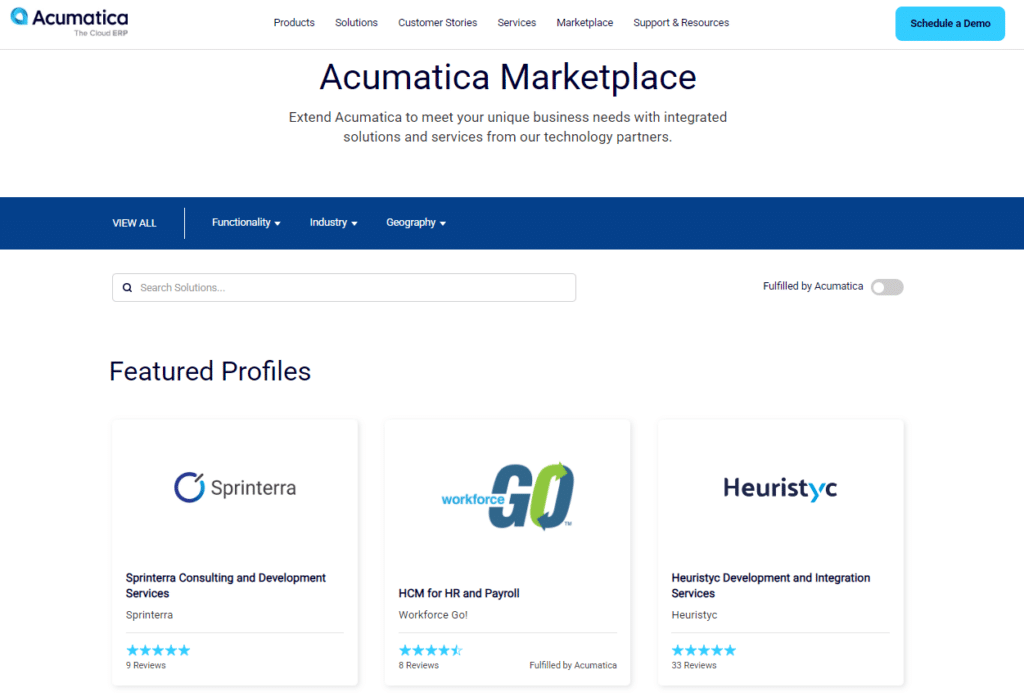
Acumatica Cloud ERP Security Safeguards
When choosing an Acumatica Cloud ERP plan, it is especially important to consider the security features that protect your data. Acumatica offers multiple security levels with features like role-based access controls, federated security options such as Single Sign-On (SSO), and encryption protocols like AES and TLS 1.2 for securing data during transmission and storage. Data is secured across all stages, including application, transmission, storage, and physical security. Acumatica is also hosted on secure platforms like AWS, which ensures compliance with regulations such as PCI DSS and GDPR.
While the core security features are consistent, your team should also assess adding other safeguards, like multi-factor authentication, to enhance protection. These features can help mitigate risks associated with cyberattacks and data breaches.
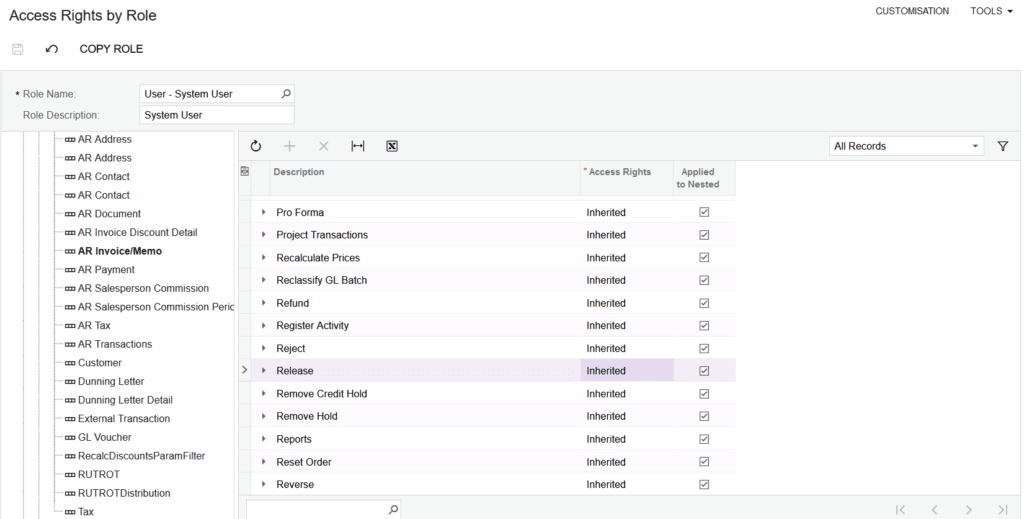
Acumatica Cloud ERP Pricing FAQs
Here are answers to a few common questions about Acumatica Cloud ERP pricing:
What additional costs should I anticipate with Acumatica Cloud ERP?
When considering Acumatica Cloud ERP, additional costs may include expenses related to implementing additional applications, increased resource consumption, and choosing a specific license type. Businesses should also account for potential costs associated with expanding resource levels and data storage as their needs grow.
Are there any discounts or promotions available for Acumatica Cloud ERP?
Currently, Acumatica offers interested parties the opportunity to schedule a free, no-obligation pricing review with an Acumatica expert. This consultation can help businesses identify the most appropriate plan based on their needs and may also uncover potential discounts or promotions tailored to their specific situation.
For the most accurate and up-to-date information on discounts, businesses are encouraged to contact Acumatica directly.
How often does Acumatica Cloud ERP change its pricing structure?
Historically, ERP providers review their pricing structures periodically to reflect changes in market demands, innovation, and consumer usage patterns. For any recent changes or specific pricing updates, businesses are encouraged to directly contact Acumatica.
Does Acumatica Cloud ERP offer unlimited user access?
Yes, Acumatica Cloud ERP provides access to an unlimited number of users without requiring payment for individual user seats. This consumption-based licensing model allows businesses to scale operations seamlessly as they grow, without worrying about additional costs for adding users.
What factors influence the cost of Acumatica Cloud ERP?
The cost of Acumatica Cloud ERP is primarily influenced by three factors: the number of applications implemented, the projected resource consumption, and the chosen license type. This pricing structure allows businesses to pay based on actual usage and adapt their resources according to their needs.
Can businesses adjust their Acumatica Cloud ERP resources and data storage?
Yes, Acumatica Cloud ERP’s pricing model is designed to be transparent and adaptable. Businesses can modify their resource levels and data storage as needed, allowing them to efficiently manage their operational requirements as they evolve. This flexibility ensures that organizations can scale without facing unexpected costs.
Is Acumatica Cloud ERP Good Value?
In my opinion, Acumatica Cloud ERP offers good value for businesses seeking a flexible and scalable ERP solution. Its modular design allows companies to pay only for the features they need, which makes it appealing to small and mid-sized enterprises, particularly in manufacturing, distribution, and retail industries.
The software’s intuitive interface and extensive integration capabilities also enhance its functionality, allowing it to easily adapt to existing business processes. While initial onboarding may require an investment in training, the comprehensive support offered by Acumatica, including live webinars and tutorials, can help mitigate these challenges.
Moreover, the platform's strong analytics and reporting tools, combined with multi-entity management and flexible resource consumption, make Acumatica particularly beneficial for environments with complex supply chain requirements.
Verdict: Acumatica Cloud ERP is a strong contender for businesses seeking a cost-effective and adaptable ERP solution.
Want to learn more about Acumatica Cloud ERP? Check out their site for additional information.
Pricing available upon request
Free demo available
What’s Next?
Ready to compound your abilities as a finance professional? Subscribe to our free newsletter for expert advice, guides, and insights from finance leaders shaping the tech industry.












